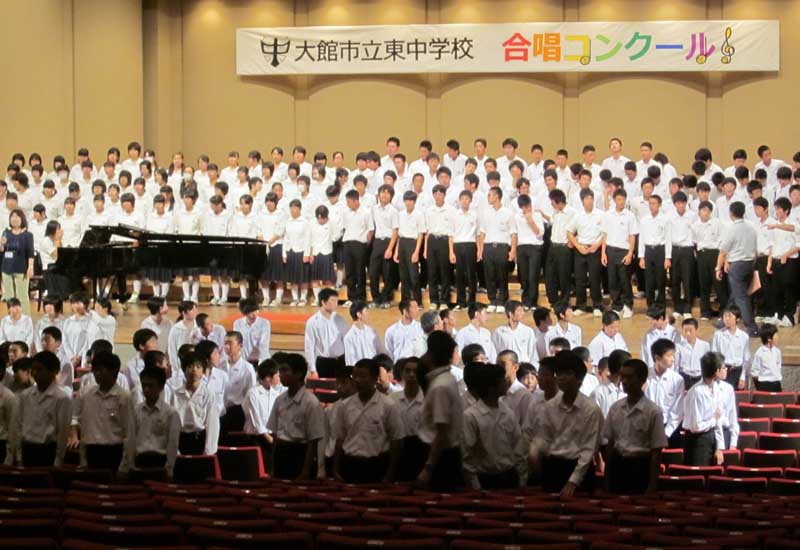Experiencing the Inaka Life Teaching English in Odate, Japan
Written By: Carey Bibb | Updated: June 29, 2023
Written By: Carey Bibb
Updated: June 29, 2023

When I found out that I was accepted into the JET Programme for teaching English in Japan I was thrilled! Even without any Japanese experience, I had been accepted into one of the most widely acclaimed companies for teaching English in Japan. But a month later, when I received news of my placement, I was told that I would be in “Odate-shi 大館市, which is located in Akita-ken 秋田県”. I had never heard of Odate before, and the only thing I knew about “Akita” (which at the time I still pronounced in the American style with the emphasis on the “ki” instead of the “A”, where the emphasis truly belongs) was that it was a type of dog. I immediately raced to Google, hoping that I could learn more about my future city, but with a scarce Wikipedia article, Google images consisting of maps, a large dome, and a statue of a dog, I still had no idea what I was getting into. However, I accepted the placement anyway, excited to move to a foreign country to teach English abroad.
 After more in depth Googling, I learned that the dog statue was a statue of “Hachiko”, a dog famous around the world for loyalty. Hachiko waited in Tokyo every day at a train station for its owner, continuing for ten years after its owner had passed away. I had heard the story of a faithful dog before; even TV programs such as “Futurama” and “Teenage Mutant Ninja Turtles” referenced this story in some way. However, I knew very little about the dog itself. And I definitely didn’t know that this famous dog was born in the city of Odate, the city that I was placed in for the JET Programme. I accepted my placement and came to Odate - a city with one McDonald’s, one KFC, and more ramen shops than a person could visit in a lifetime. I have been here for almost four years and will stay for a fifth because I love this city and I hope that other people will come to love Odate as I have.
After more in depth Googling, I learned that the dog statue was a statue of “Hachiko”, a dog famous around the world for loyalty. Hachiko waited in Tokyo every day at a train station for its owner, continuing for ten years after its owner had passed away. I had heard the story of a faithful dog before; even TV programs such as “Futurama” and “Teenage Mutant Ninja Turtles” referenced this story in some way. However, I knew very little about the dog itself. And I definitely didn’t know that this famous dog was born in the city of Odate, the city that I was placed in for the JET Programme. I accepted my placement and came to Odate - a city with one McDonald’s, one KFC, and more ramen shops than a person could visit in a lifetime. I have been here for almost four years and will stay for a fifth because I love this city and I hope that other people will come to love Odate as I have.
As is the case with many cities in rural Japan, the population of Odate has been steadily decreasing over the last four years that I have lived here, and it doesn’t seem that will stop any time soon. The population of Odate is getting older and older, and the younger people are moving away to bigger cities around Japan where they have opportunities to be around people their own age. There is a very noticeable deficit of people between the age of 18 and 35 in Odate, so I can’t blame them for wanting to move away, especially because most of the jobs in the area are in farming, food industries, and teaching. But something has to be done about the declining population. Since I have been in Odate, one elementary school, two junior high schools, and two senior high schools have closed forever, merging with other schools around the area. And in the next few years, it seems as if more schools will be closing their doors, the buildings turned into ‘community centers’, but still generally unused.

In the time that I have lived in Odate, there has been a big push to increase tourism. Currently, the majority of tourists who visit Odate come here between travel to some of the surrounding cities with big festivals and events. I have had people stay with me with ‘couch surfing’, though they admit that Odate is just a convenient stop on the way to their real destination of Aomori City, Akita City, Morioka, and sometimes even Tokyo or Sapporo (Odate is almost exactly halfway between the two). Most of the push has been centered on Hachiko; a lot of the new tourism brochures and posters mentions the fact that Odate is ‘Hachiko’s birthplace’. I look forward to coming back to visiting Odate after my job here has ended, and I hope that I will be able to see a growing, prospering city. Hopefully the push for increased tourism will work and more people will move here and start families, increasing the declining population.
If any of you who are reading this article want to get a sense of the ‘true Japan’, then I wholeheartedly recommend you come visit Odate. The people are friendly, the scenery is gorgeous, and there is a convenient (and comfortable) nine hour night bus from Tokyo so you don’t even have to miss any daytime activities. You should come in the spring when the cherry blossoms on the river’s edge are in full bloom, in the summer during festival season when the sound of the taiko and flutes echo throughout the streets, in the fall when the leaves change to red and the temperature is perfect, or in the winter to curl up with a hot cocoa inside and watch the snow or visit the mountains in the surrounding areas to experience amazing skiing and snowboarding.

There isn’t a bad time to visit Odate, and hopefully with the push for tourism increasing, more tourists around Japan and from other countries will come to experience my second home and love it as much as I do. Even after I leave Odate, I will still come back for visits to see my students graduate and to yell “Washoi” while pulling a float, soaking wet during the inevitable rain storms during September festivals. I never would have known that Odate existed if I didn’t decide to teach EFL in Japan, but now that I know about Odate, I will try to explore small cities in other countries.
If you only visit the capital city of a country, you will never truly experience a country. You have to go to the smaller cities in order to truly discover a place. Because of the online TEFL class that I took through International TEFL Academy, now I will be able to travel to many other countries and teach English, and hopefully those places will touch my heart as strongly as Odate.
Posted In: Teach English in Asia, JET Program, Teach English in Japan, Odate
Carey Bibb
Carey Bibb is originally from a small city in Maryland, an hour and a half south of Baltimore, but has lived in another small city in Japan for the past four years. She studied history and psychology in university but is now a TEFL certified English teacher. Her two passions are traveling and teaching, and now she is lucky enough to have combined the two by teaching English in Odate, Japan.
Want to Learn More About Teaching English Abroad & Online?
Request a free brochure or call 773-634-9900 to speak with an expert advisor about all aspects of TEFL certification and teaching English abroad or online, including the hiring process, salaries, visas, TEFL class options, job placement assistance and more.
"I chose ITA for two reasons. First, it offers a top online TEFL course option. Second, I found the ITA student experience stories really authentic and motivating. Hearing their experiences made me feel comforted."

- Alexandra Eilinsfeld
Teaches English in Japan







